
 | SOCO Blog |
22 May 2015
SPRING GALAXIES GALORE
Astronomically, springtime is the time for galaxies. Leo, Coma Berenices, Virgo, Canes Venatici, and Ursa Major are high in the sky after dark, and these constellations contain some of the largest concentrations of galaxies available for observation. Deep-sky imaging of these regions shows literally millions of galaxies. Thousands can be viewed with modest sized telescopes, although most will appear as little more than small fuzzy patches of light in scopes the size of the SOCO 120-mm refractor. Still, there are a number of relatively close galaxies that do show considerable detail when imaged using the equipment at SOCO. In this entry, I will present recently acquired imagery of five of such galaxies, all from Messier's list and chosen in part to exhibit the diversity that can be seen in galaxy form.
First, a few comments on the imagery. All images were obtained using the QSI Model 583 digital camera with the TeleVue 2X PowerMate focal extender. As described in the Equipment Section of this website, this setup doubles the effective focal length of the telescope and magnifies the size of the observed object within the image frame. Each color composite image was created from six to nine 15-minute images in each of the red, green and blue spectral bands. The imagery was processed using the procedures outlined in the Image Processing Section of this website. I am now confident that these procedures produce "true color" renditions of the objects without any subjective manipulation of the image color balance. In other words, the color of the galaxies in the images is their real color. Even with long exposures, these galaxies were very faint in the original 16-bit imagery (except for the central cores of some of them). The color composites had to undergo extensive contrast-stretching to produce 8-bit versions (what are displayed on your computer's monitor) that showed the details in galaxy structure without substantial saturation. One side-effect of this stretching is that the brighter stars in the imagery do not exhibit sharply defined edges but rather appear "soft" and fuzzy. This was an unavoidable consequence of the contrast stretching, where the quality of the image of the galaxy was considered more important than the quality of the images of individual stars. And, of course, all individual stars in the images are foreground stars in our own Milky Way galaxy.
The first galaxy is M 108 (NGC 3556) in the constellation Ursa Major, the Great Bear. When I first saw the image, I thought that the galaxy might be an irregular type, like M 82. In reality, it is a spiral galaxy that we view almost edge-on. The galaxy has a lot of dark dust clouds along its major axis which largely obscure the outer edges of the galaxy on either side of the bulging central region. A few pinkish HII regions (emission nebulas like the Rosette Nebula) can be seen along the dark lanes near the visual center of the galaxy.
M 108 is thought to be a member of the Ursa Major Group that lies at around 45 million LY from us. The galaxy has a diameter of around 100,000 LY. Visually, it has an apparent size of 8.7 X 2.2 arc-minutes, large enough to be a good target for the SOCO scope. It was discovered by Pierre Mechain (Messier's colleague) in February of 1781, but was not included in Messier's original publication. It was included as a Messier object only in 1953, when several objects mentioned in Messier's or Mechain's notes or correspondence were added to the overall list.
As visible in the image, there are three foreground stars lying on top of the galaxy. The brightest of the three near the visual center of the galaxy is often mistaken for the core of the galaxy. The actual core of the galaxy can't be seen in visible wavelengths due to the dust clouds. These stars have also been mistaken for supernovas in the galaxy. If you look carefully, you'll see that the brightest of the three stars has a small companion (just to its right). This companion has been called Brenner's Star and is used as a test of a telescope's resolution. To visually detect this companion star, you typically need a scope with at least a 20-inch mirror and a magnification of over 300X.
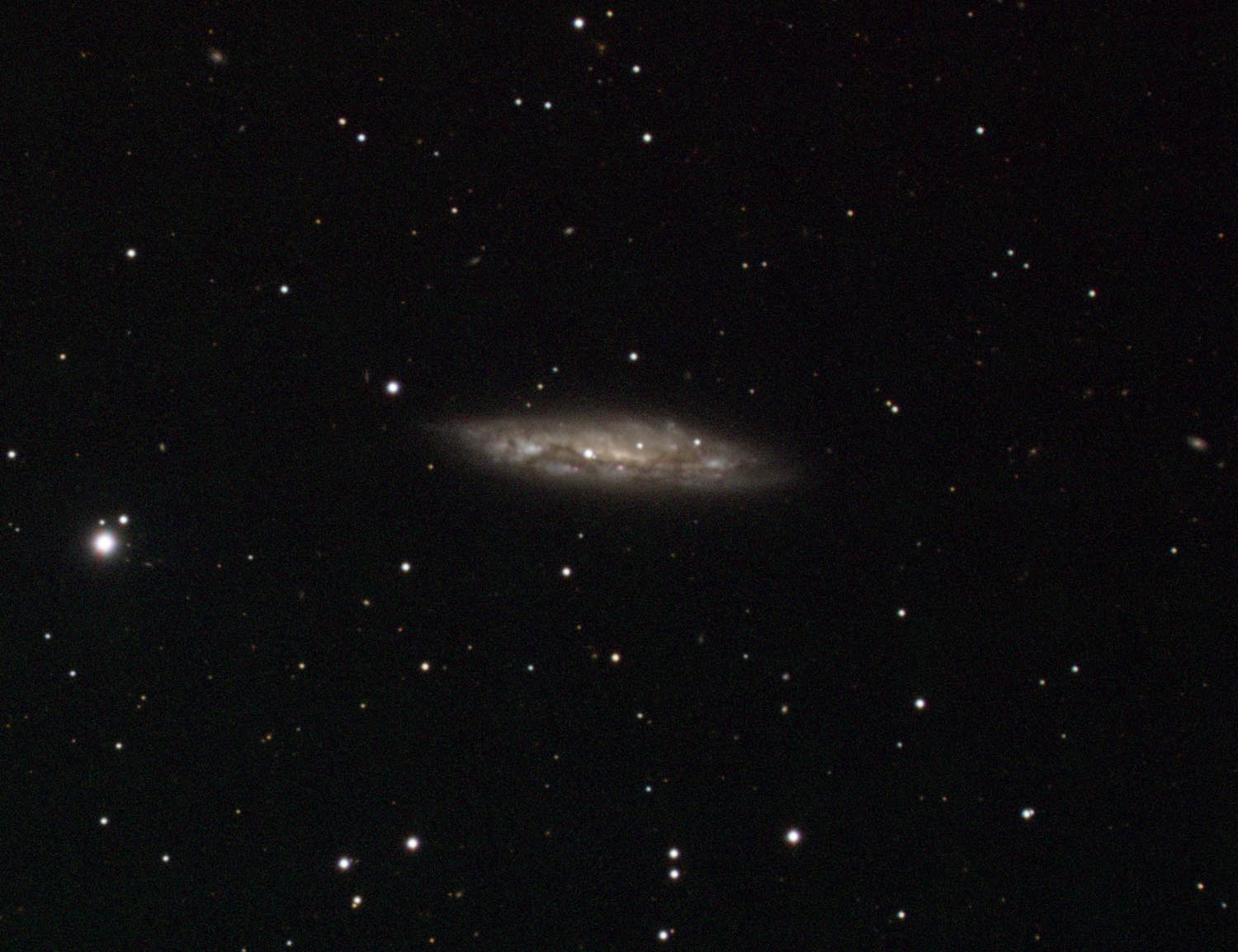
M 108 (NGC 3556)
Whereas it is difficult to determine that M 108 is a spiral galaxy, there is no question about the nature of our next object. This is M 106 (NGC 4258), located in the constellation Canes Venatici, the Hunting Dogs. M 106 is a grand spiral galaxy reminiscent of the Andromeda Galaxy (M 31). At around 25 million LY, it is ten times as far away as M 31, which accounts for its smaller visual size. Still, it has an apparent size of 18.6 X 7.2 arc-minutes, which makes it easily resolvable in the SOCO scope. Physically, M 106 is a huge galaxy, with a diameter of around 135,000 LY. Its two arms originate from a barred structure surrounding the galaxy's core and wind outward, each making more than one complete turn around the galaxy. To me, the arms do not appear symmetric, with the plane of the lower arm inclined a bit relative to the upper arm. This may be related to something happening in the core of M 106, since radio observations have detected jets shooting out from the core at an angle of around 30 degrees relative to the plane of the galaxy. M 106 is thought to harbor a massive black hole in its center. Numerous pinkish HII regions are visible in the arms, particularly where they depart from the central section of the galaxy.
M 106 is thought to be part of the Coma-Sculptor galaxy association. It is itself the center of a local group of 17 objects. Easily visible in my image is NGC 4248, an irregular galaxy lying around 13 arc-minutes to the northwest of M 106. There is some debate as to whether NGC 4248 is actually a physical companion of M 106. Measurements of the neutral hydrogen field around the galaxies suggests that they may be a physical pair around a million LY apart. Some have speculated that, if this is the case, looking at the combination of M 106 and NGC 4248 would be like looking at our Milky Way galaxy and the nearby Large Magellanic Cloud. M 106 was discovered by Mechain in 1781, and is another one of those objects later added to the Messier list.
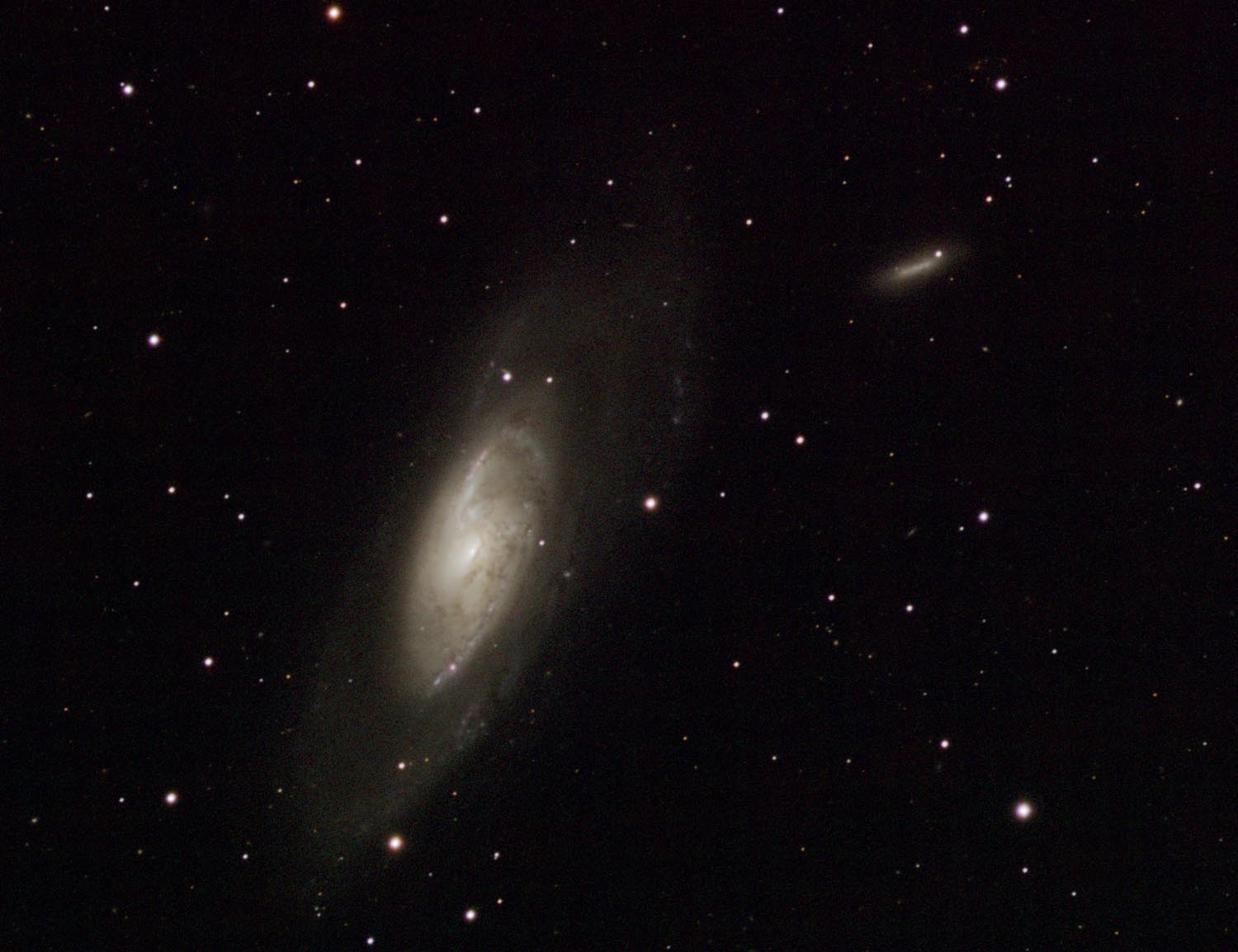
M 106 (NGC 4258) and nearby galaxy NGC 4248
We see M 94 (NGC 4736) face-on, and it is one of the strangest-looking galaxies I've seen. While classified as a spiral galaxy, different waves of star formation have divided the overall structure into zones with marked differences in appearance. At its center, M 94 has a bright starlike core that is easily visible in binoculars. Around this core is a circular zone of older, redder stars extending out to a radius of around 0.5 arc-minutes. Outside this central region, the dynamics of the galaxy's rotation cause interstellar matter to be compressed to trigger the formation of many new stars. This "starburst" region can be seen in the image as the bright, turbulent-looking ring circling the darker central zone. Outside this starburst region, the structure of the galaxy's disk looks relatively uniform (no obvious spiral arms like in M 106), with traces of the spiral structure indicated by darker dust lanes. There is little new star formation in this zone, and older stars prevail. At around 3.5 arc-minutes from the center, the edge of this zone appears fairly abrupt, with mostly darkness beyond the edge. However, if you look very carefully at the image (it may help to step back from the computer screen), you can detect a faint outer ring circling the galaxy with a brightness barely above the background level. This makes the diameter of the whole galaxy structure more than 15 arc-minutes. What an incredibly complex object!
M 94 is thought to be part of the same group of galaxies that includes M 106. It has a actual diameter of around 56,000 LY, and lies at a distance of around 17 million LY.
M 94 was discovered by Mechain on the 22nd of March, 1781. Messier observed it two nights later. He described it in his notes as "Nebula without star, its center is brilliant, the nebulosity slightly diffuse. It resembes the nebula which is below the Hare, No. 79: but this one is finer and more brilliant." When Messier described it as "without star", he meant that he could not resolve it into individual stars. His statement regarding No. 79 in "the Hare" is a reference to M 79 in the constellation Lepus. This is interesting, because M 79 is a globular cluster found along the edge of our own Milky Way galaxy (only 45,000 LY away). This says something about the ability of Messier's telescopes to resolve two very different types of objects.
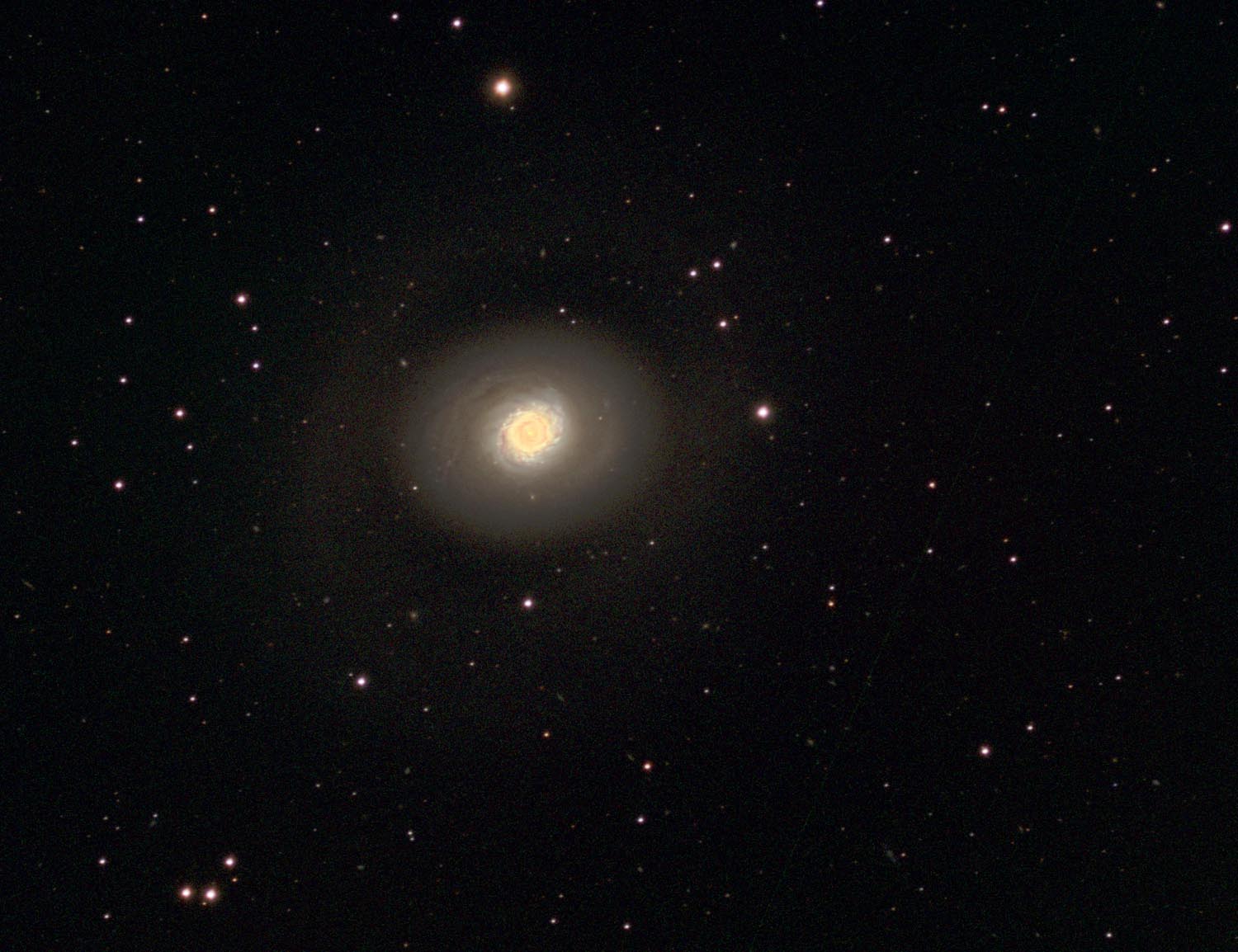
M 94 (NGC 4736)
The fragmented, "flocculent" multiple-arm structure of M 63 (NGC 5055) has caused it to be called the "Sunflower Galaxy", which suggests that its appearance is similar to the face of a sunflower. This complex arm structure is thought to similar to that of our own Milky Way galaxy. The appearance of this structure is accentuated by multiple lanes of dark dust, and a broader lane of dust encircles the outer periphery of the galaxy. Lighter, slightly pinkish HII regions dot the galaxy's disk. The core of M 63 is very bright and stellar in appearance, and stands out even in small telescopes. M63 is located around 27 million LY away in a group of galaxies that includes M 51, the "Whirlpool Galaxy" (the galaxy shown under the navigation buttons along the left side of the SOCO main page). It has a diameter of just under 100,000 LY, which makes it a bit smaller than our Milky Way (at 100,000 to 120,000 LY).
M 63 was the first galaxy discovered by Messier's colleague Pierre Mechain. He discovered it while following a bright comet in 1779. Messier himself observed M 63 on the 14th of June, 1779. In his notes, he remarked that it appeared similar to his object No. 59, which is a large elliptical galaxy in the constellation Virgo. The spiral structure of M 63 wasn't determined until the 1800's with observations by Lord Rosse and others.
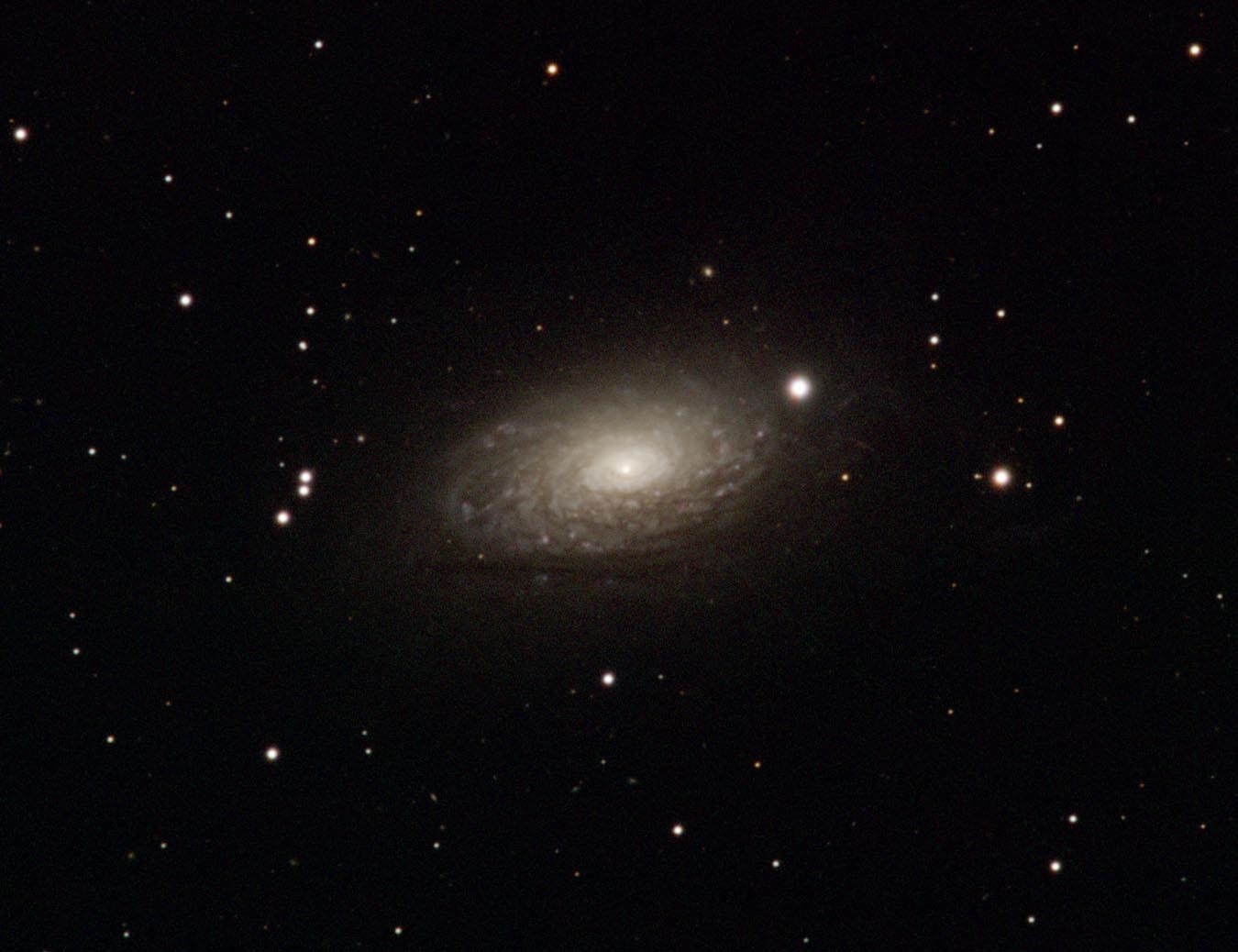
M 63 (NGC 5055) The Sunflower Galaxy
The last of the five galaxies, M 64 (NGC 4826), also has a unique nickname— the "Black Eye Galaxy."
In my image, the upper part of the galaxy is tipped toward us. A band of dark dust circles the core of the galaxy. The far side of this structure is washed out by the brightness of the core, but we see the back side in shadow on the near (upper) side of the galaxy. The result is a dark crescent above the bright core reminiscent of the "shiner" that developes when someone is punched in the eye. This feature was first noted by John Herschel in 1830, although he thought it was due to the presence of a double star. Others, such as Lord Rosse, also thought M64 was a star cluster. The question was finally put to rest by Curtis in 1918, who described in detail the actual structure of the galaxy based on extensive photographic investigations.
If the early uncertain nature of this object is not enough, M 64 also had three independent discoverers. It was first observed by the Englishman Edward Pigott on the 23rd of March, 1779. Twelve days later, the Prussian Johann Elert Bode (Messier's competitor in deep-sky discoveries) independently observed it. When Messier observed it on the 1st of March, 1780, he was unaware of the two other discoveries. They definitely could have used the Internet in those days.
M 64 has a relatively modest size (56,000 LY in diameter) and lies in the constellation Coma Berenices at a distance of around 18 million LY. It lies in a small group of neighboring galaxies that possibly includes M 94. It was once thought to be part of the Virgo cluster of galaxies, but its currently determined distance puts it only around a third of the way to that group.
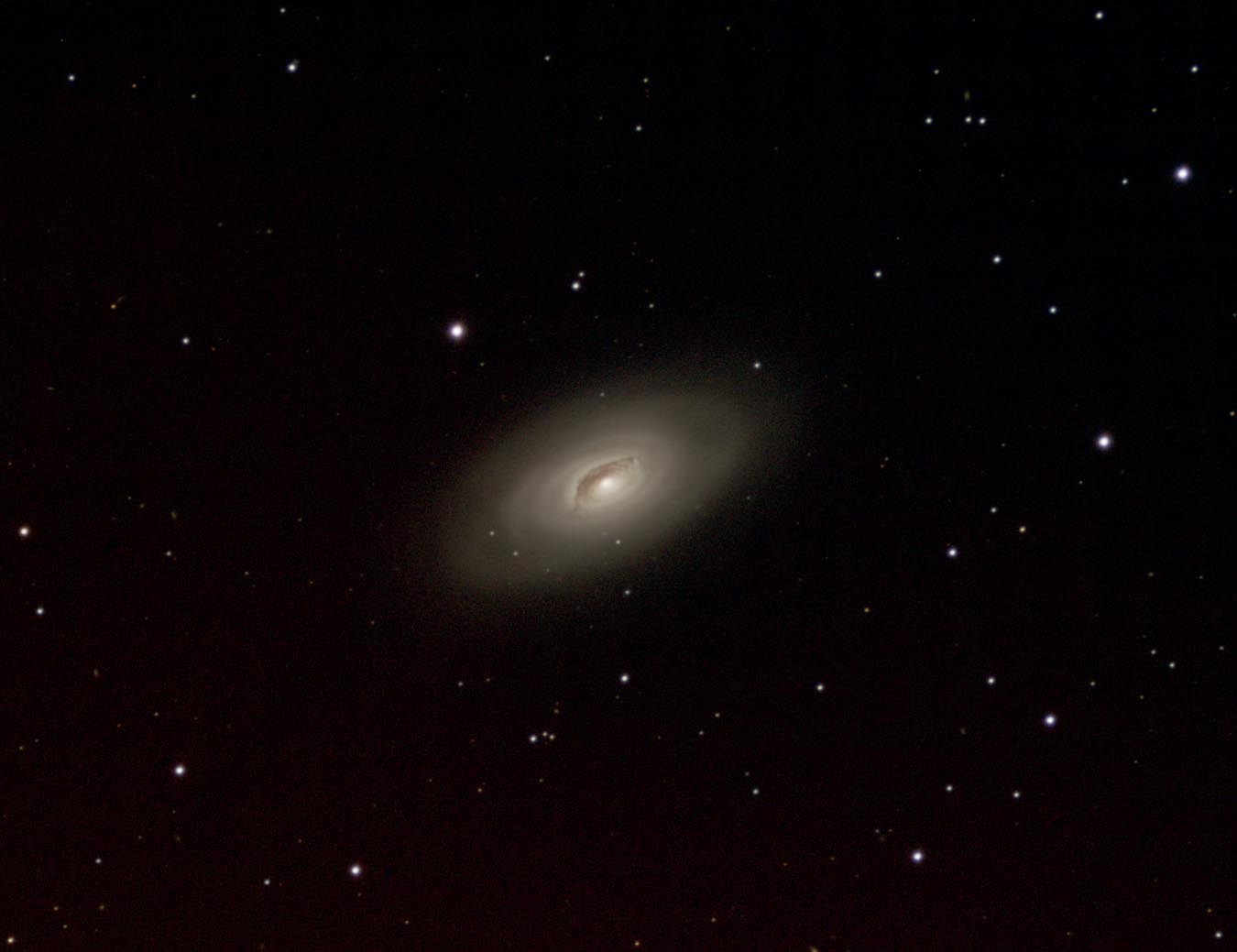
M 64 (NGC 4826) The Black Eye Galaxy
It's amazing that we can get such diversity in form and structure from a subset of only five spiral galaxies. The old statement, "If you've seen one, you've seen them all," definitely does not apply to galaxies. With literally millions of them observable to individuals with modest-sized telescopes, you could easily fill a lifetime with observations and probably not see exactly the same thing twice. Galaxies are the snowflakes of space.
 Return to SOCO Blog Page
Return to SOCO Blog Page
 Return to SOCO Main Page
Return to SOCO Main Page
Questions or comments? Email SOCO@cat-star.org